#australian shelduck
Text
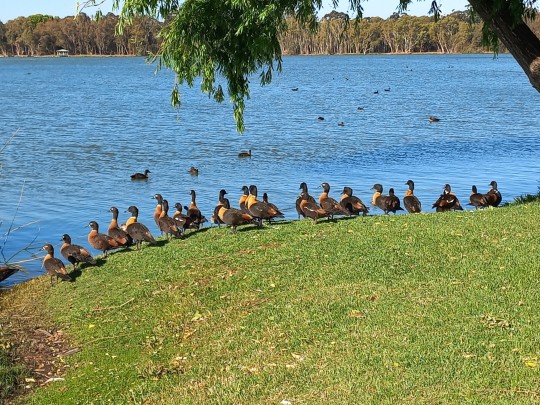
Today's bird is the Australian Shelduck! Usually these guys are found in mating pairs but after breeding/nesting season they can gather in large flocks and are flightless for some time as they are moulting.
344 notes
·
View notes
Text
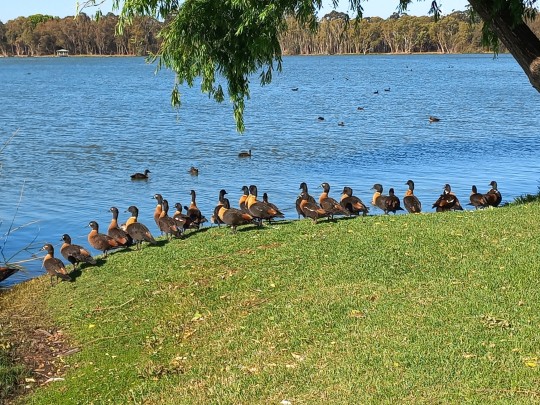
A large gathering of Australian Shelducks (28/11/23)
7 notes
·
View notes
Text
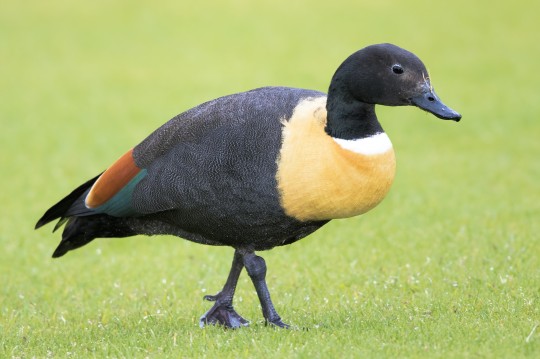
[464/10,977] Australian Shelduck - Tadorna tadornoides
Order: Anseriformes
Family: Anatidae (ducks, geese and swans)
Subfamily: Tadorninae
Genus: Tadorna (shelducks)
Photo credit: Mark Chappell via Macaulay Library
#birds#Australian Shelduck#Anseriformes#Anatidae#Tadorninae#Tadorna#birds a to z#undescribed#0% - 25%
11 notes
·
View notes
Text
Tadorna ferruginea / Ruddy Shelducks chase Tadorna tadornoides / Australian Shelducks off their perch at the Sarah P. Duke Gardens at Duke University in Durham, NC
#Tadorna ferruginea#Tadorna tadornoides#Tadorna#Ruddy Shelduck#Australian Shelduck#Mountain duck#Chestnut-breasted Shelduck#Shelduck#Ducks#Birds#Nature photography#photographers on tumblr#Sarah P. Duke Gardens#Duke Gardens#Duke University#Durham#Durham NC#North Carolina
1 note
·
View note
Text
In Australian Shelducks, it is the females who vigorously pursue males, often courting already paired drakes in dramatic aerial chases.
"Biological Exuberance: Animal Homosexuality and Natural Diversity" - Bruce Bagemihl
#book quote#biological exuberance#bruce bagemihl#nonfiction#australian shelduck#tadorna tadornoides#pursuit#harassment
0 notes
Text
Lesser Scaup Ducks are highly social, gathering into large waterborne flocks or "rafts" that may number in the tens of thousands. (...) Australian Shelducks also down mated pairs during the breeding season (both parents care for the young) but otherwise associate in flocks. Musk Ducks are largely solitary except during the mating season; adult males are territorial, and they are probably polygamous or promiscuous (copulating with more than one female).
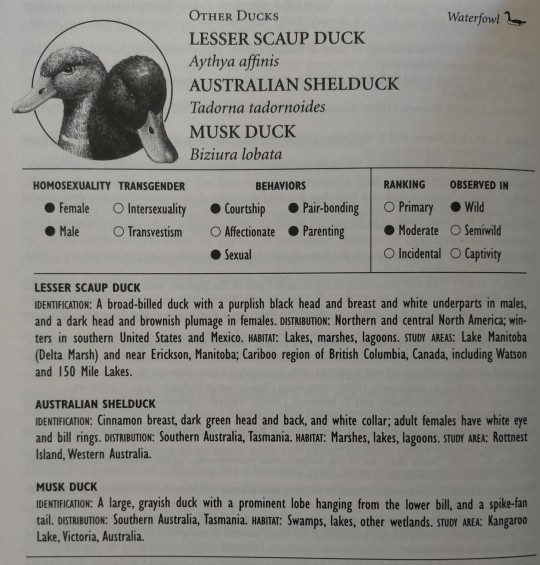
"Biological Exuberance: Animal Homosexuality and Natural Diversity" - Bruce Bagemihl
#book quotes#biological exuberance#bruce bagemihl#nonfiction#lesser scaup duck#aythya affinis#australian shelduck#tadorna tadornoides#musk duck#biziura lobata#social#flock#rafts#mated pair#breeding season#solitary#territorial#polygamous#promiscuous
0 notes
Text
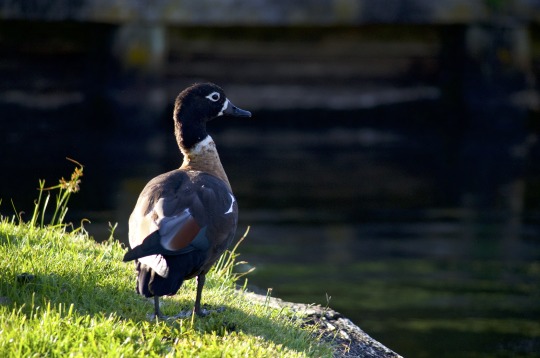
Australian Shelduck
#birdphotography#wild birds#birding#birb#australian birds#bird#bird watching#duck#australian shelduck#shelduck
0 notes
Text
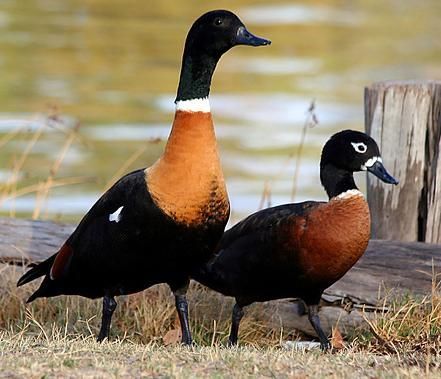
Australian Shelduck pair
#pinterest#nature#beautiful#nice#lovely#aesthetic#wonderful#mood#duck#ducks#drake#poultry#waterfowl#bird#birds
23 notes
·
View notes
Text
Day 10 of Australia vacation, part 2: Quoll Patrol
We drove to Scottsdale, checked into the heritage B&B where we would stay for the next couple nights, and then set off on a private wildlife and scenery tour--just the four of us with a local guide.
Some of the places we went were spots we might have visited on our own, but some we wouldn't have had access to, and a lot of the driving was on unpaved back roads so we got to see quite a bit of territory we certainly wouldn't have seen without the guide. And we really enjoyed it and saw many birds and marsupials! The guide was knowledgeable, identifying many birds by sound and many with only a brief glimpse. That said, I'm not sure this is the tour company I would've chosen if there hadn't been itinerary negotiations with Brother-in-law during the planning stage for the trip. Still, they get points for the rhyme-y name of Day's 10's tour!
He first took us to private farmland with a large pond so we could spot some birds. We saw many that were new to me, including a white-faced heron, a black-fronted dotterel, musk ducks (including some ducklings riding on their mother!), chestnut teals, Australian shelducks, and, in a field, an Australian pipit. Then, while driving to the next destination, we pulled over when we spotted a white-bellied sea-eagle soaring overhead! That was really exciting! A majestic bird. We also saw a gray currawong on the drive, though I'm not sure I could distinguish it from a black currawong and I just took the guide's word for it.
We drove up to Ben Lomond National Park (named after the mountain in Scotland). There were some gorgeous views from the foresty part, and then when we got just above the treeline, we could see the dolerite peaks. It was beautiful! We spent a few minutes there before driving even further up, to the ski village (which was of course closed as it is summer there now and there was no snow). That area was somewhat reminiscent of moorlands in northern England, and all of the bushes were in bloom. There were lots of wallabies around, and some fantastic views before the fog fully rolled in--though it was already too foggy to see the ocean on the other side. We also heard and spotted some crescent honeyeaters. There may have been other birds too--I heard a lot of birdsong (including one that kept singing "figaro figaro figaro"), but I couldn't find any more of them and the guide had set us loose on a short-ish walk without him.
We then drove back down out of the fog, eventually stopping for a few minutes in a forest clearing where we could hear dozens of birds, but none of them showed themselves. Since I'm the only one of the four of us who is obsessed with birds, we didn't wait too long before moving on.
Finally we drove on some back roads, including crossing through a small river, to a large pasture with a sort of shack and an outdoor fireplace. The tour company leases this spot from a timber company. It was getting to be evening, and many kangaroos, wallabies, and pademelons (smaller wallaby-like creatures) were grazing on the pasture. It turned out, however, that the guide feeds them when he brings people there, so the kangaroos all came right up to us expecting food. Kangaroos are tall! I was a bit intimidated, and I also felt that it was not a good thing to feed wild animals and make them more tame. It was just not as much of an eco-tour as I would've preferred.
On the other hand, it did mean we had a close look at the animals, and Brother-in-law actually spent a while scratching one of the kangaroos, to their mutual great delight. The wallabies and pademelons were very cute and much less tame.
The guide started a fire (I had to put on all my layers of clothing as it was chilly and a bit drizzly) and prepared us a picnic meal; we ate and chatted and admired the various macropods. Eventually, as it got later, the quolls that live under the shack emerged. They were ridiculously cute! And then, once it was dark, the brush-tail possum turned up. So we certainly saw plenty of nocturnal creatures, particularly as we spotted some wombats grazing on our drive out. We also passed (by the side of the road) a darker colored quoll of a different species.
It was pretty late when we got back to the B&B. We arranged to meet our guide at 10am the next day for Wilderness and Waterfalls.
6 notes
·
View notes
Photo
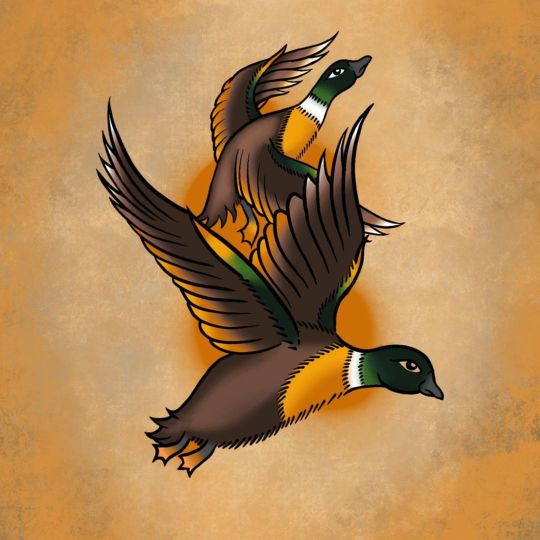
New Design Available - Australian Shelduck #tattoo #tattooapprenticeship #apprenticetattoo #abandonedart #tattooapprentice #art #abandonedartdonnybrook #training #bunbury #donnybrook #southwest #local #localartist #shelduck #traditionaltattoo https://www.instagram.com/p/ChRKX1_rROP/?igshid=NGJjMDIxMWI=
#tattoo#tattooapprenticeship#apprenticetattoo#abandonedart#tattooapprentice#art#abandonedartdonnybrook#training#bunbury#donnybrook#southwest#local#localartist#shelduck#traditionaltattoo
0 notes
Photo
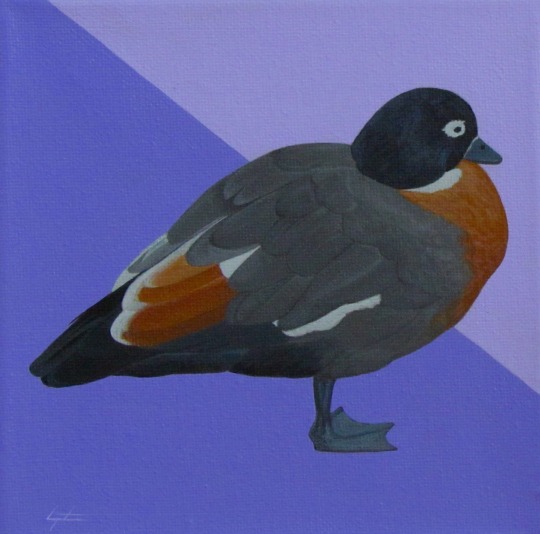
Australian Shelduck
Seen at The Cheyenne Mountain Zoo, Colorado Springs, Colorado.
Acrylic on canvas 6x6".
Charles Morgenstern, 2020.
Artwork for sale at tetramodal.com
#artists on tumblr#illustrators on tumblr#australian shelduck#duck#ducks#bird#birds#animal#animals#nature#wildlife#zoo#painting#acrylic#realism#portrait#tetramodal#charles morgenstern#cheyenne mountain#colorado springs#impressionism#expressionism#surrealism#popsurrealism#pop#minimalism#art#artwork#illustration#australia
98 notes
·
View notes
Photo
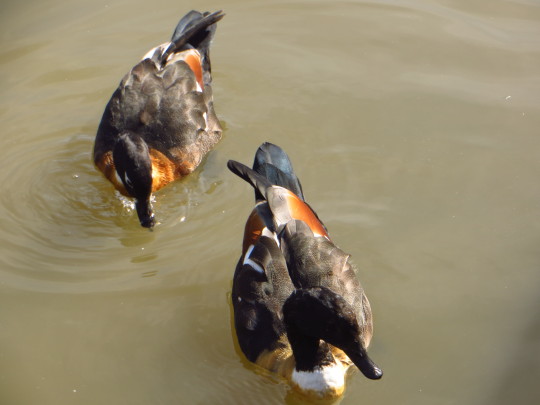
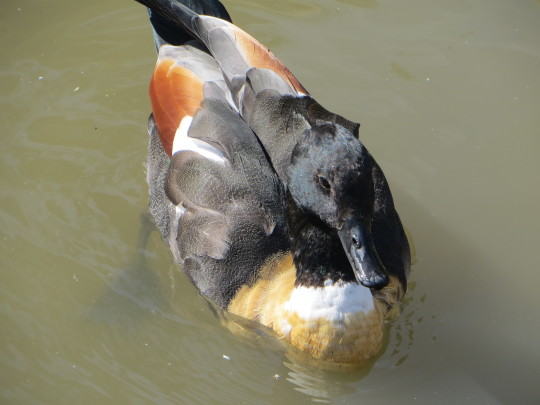
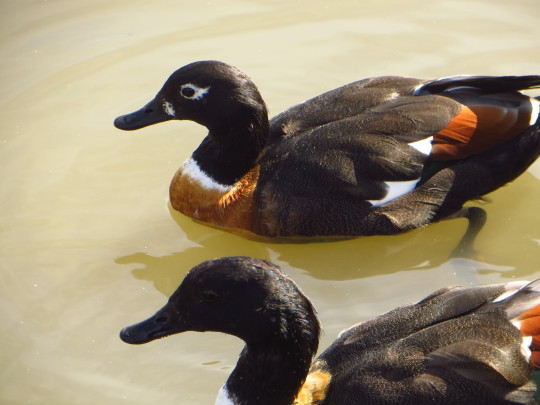
A few beautiful Australian Shelducks at WWT Slimbridge, looking super glossy and gorgeous in the sun.
Native to Australia, as the name suggests, these large ducks nest in tree hollows or in holes on banks. The female is distinguished by a ring of white feathers around the eye, as in the bottom pic.
#ducks#cute ducks#shelduck#australian shelduck#cute birds#cute animals#duckdaysout#duckfacts#wwt slimbridge#wildlife photography
25 notes
·
View notes
Text
Tadorna
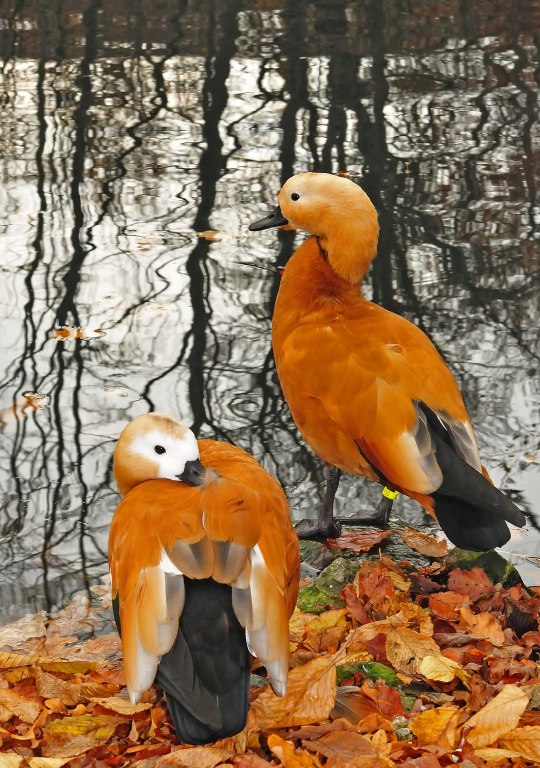
Ruddy Shelduck by Michael Gäbler, CC BY 3.0
PLEASE SUPPORT US ON PATREON. EACH and EVERY DONATION helps to keep this blog running! Any amount, even ONE DOLLAR is APPRECIATED! IF YOU ENJOY THIS CONTENT, please CONSIDER DONATING!
Name: Tadorna
Status: Extant
First Described: 1822
Described By: Boie
Classification: Dinosauria, Saurischia, Eusaurischia, Theropoda, Neotheropoda, Averostra, Tetanurae, Orionides, Avetheropoda, Coelurosauria, Tyrannoraptora, Maniraptoriformes, Maniraptora, Pennaraptora, Paraves, Eumaniraptora, Averaptora, Avialae, Euavialae, Avebrevicauda, Pygostylia, Ornithothoraces, Euornithes, Ornithuromorpha, Ornithurae, Neornithes, Neognathae, Galloanserae, Anseriformes, Anseres, Anatoidea, Anatidae, Tadorninae
Referred Species: T. cristata (Crested Shelduck, extinct?) T. tadorna (Common Shelduck, extant), T. cana (South African Shelduck, extant), T. ferruginea (Ruddy Shelduck, extant), T. tadornoides (Australian Shelduck, extant), T. variegata Paradise Shelduck, extant)

Paradise Shelduck by Dick Daniels, CC BY-SA 3.0
We go back to Shelducks today with Tadorna, the ultimate shelduck, containing six species - five living, one possibly extinct. These are semi-terrestrial birds, kind of in between ducks and geese in terms of size and body shape, though they are considered ducks in general and are their own separate evolutionary lineage. These birds primarily live in the Eastern Hemisphere and have distinctive green, black, and white wing feathers. They eat primarily small shore animals like crabs, as well as some grasses. There might be some fossil evidence of this genus from the Early Pliocene, indicating this genus first appeared between 5.33 and 3.6 million years ago, in the Zanclean age.
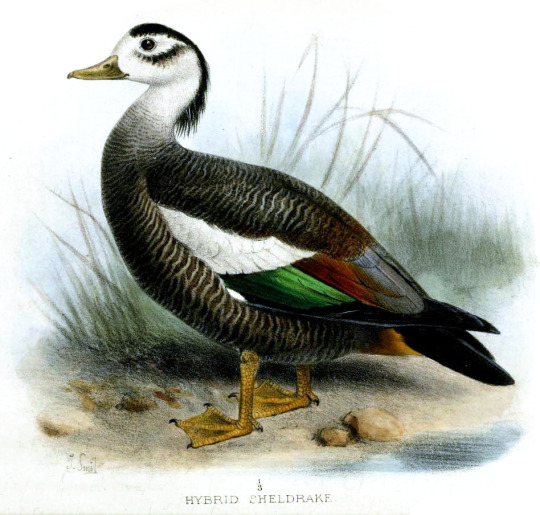
Crested Shelduck by Joseph Smit, in the Public Domain
The Crested Shelduck is potentially the earliest derived species in the genus, and if it is not extinct then it is critically endangered and almost unknown in the wild. Originally from Japan, if it is still alive it is mainly known in China, in relatively hidden and limited locations. It has not been decidedly sighted since 1964, though there have been occasional possible sightings. These birds were (are?) sexually dimorphic, with greenish-black crowns and primaries on the males, and the females having large white eye rings and black crests. They are slightly larger than mallards in terms of size, and they live primarily in wetland and deep water habitats, especially near the coast. They are probably migratory, going from Siberia in the breeding season to Korea, Russia, and Japan in the winter, feeding primarily on aquatic vegetation and mollusks and crustaceans. It has never been a very common duck, but due to habitat loss, hunting, and overcollecting, fewer than 50 species might be left in the wild - and those present might lose their habitat due to the Tumangan Development Project. Truly, a soberingly depressing tale.
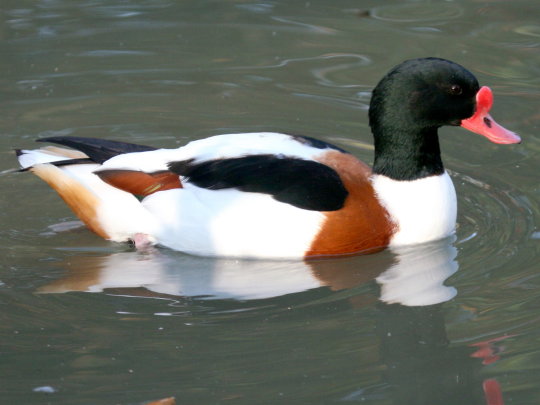
Common Shelduck by Dick Daniels, CC BY-SA 3.0
The Common Shelduck actually might also be one of the earliest derived members of the species, living around Afroeurasia and luckily not considered threatened with extinction. The bird looks sort of like a small, short-necked goose, with extremely striking plumage and even little bill flaps on the males. The sexes look mainly similar, with the females smaller and duller, especially during the breeding season. They breed in central Asia and Scandinavia, and winter in the Middle East, China, Indian Subcontinent, and southern Iberian Peninsula / northern Africa. They can, however, be found year-round in Western Europe and the British Isles. They live mainly along coastlines, associated with estuaries, tidal mudflats, and lakes and rivers near the sea. They breed in burrows, treeholes, and haystacks, and in order to evade predators the young dive underwater while the adults fly away as decoys.
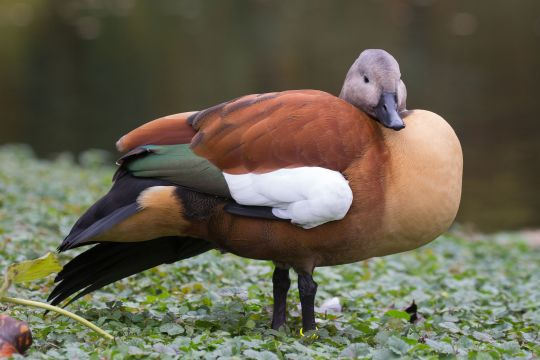
South African Shelduck by Carlos Delgado, CC BY-SA 4.0
The South African Shelduck is also not really threatened with extinction, and as indicated by its name its primarily known from southern Africa such as Namibia and.... South Africa. Many of the birds go north-east for a moulting ground in the winter, which leads to large concentrations of the bird. They live in lakes and rivers in the countryside, and they use mammal burrows for their nests. Other than the breeding season, they’re usually quite nomadic, living in mated pairs wandering about the area. They are mostly brown, with varied coloring on the wings and tail.
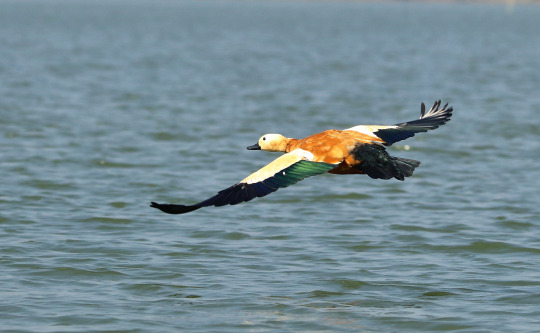
Ruddy Shelduck by Sayanti Sikder, CC BY-SA 4.0
The Ruddy Shelduck, or as I like to call it, the Halloween Duck (when it is not flying its colors are almost entirely orange and black), is a migratory bird not considered threatened with extinction from India, Central Asia, Europe, and North Africa, and they can be very large birds, growing up to 70 centimeters in length. They have iridescent feathers on their wings that break up the orange-black plumage patterns, but those are only visible during flight. They make very loud honks as calls, which is useful for them as they usually live only in small flocks or in pairs. They mainly breed in southeastern Europe across Central Asia, and they spend the winter season in India. They breed in high altitude areas and in swamps, and can most frequently be found in inland water such as lakes and rivers.
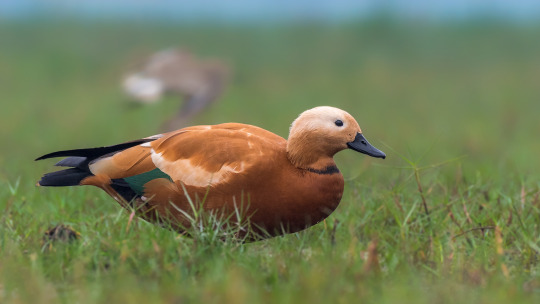
Ruddy Shelduck by Mprasannak, CC BY-SA 4.0
Interestingly enough, the Ruddy Shelduck is primarily nocturnal, a fairly unique ecology for waterfowl in general. It lives on grasses, water plants, and invertebrates, and it can dabble and up-end to gather food in water. They have strong pair bonding, with the mates pairing up for life and being very aggressive to other pairs in the breeding season. They lay their nests in trees, crevices, and burrows, lining the nest with feathers and grasses. THey lay about eight eggs, with the females incubating the eggs and the males standing guard. The eggs hatch in about a month, and fledge in close to two months, and the families stay together for a long time after fledging.

Australian Shelduck by J. J. Harrison, CC BY-SA 3.0
The Australian Shelduck is a Shelduck known from - you guessed it - Australia, primarily in New South Wales and Tasmania. They aren’t considered threatened with extinction, and the males and females look primarily the same - brown and orange, with some green and black feathers on the wings and head - though the males have white patches on the snout, eyes, and wings. They breed in Southern Australia and Tasmania, and they move farther north during the winter, and are known for being very wary and shy.
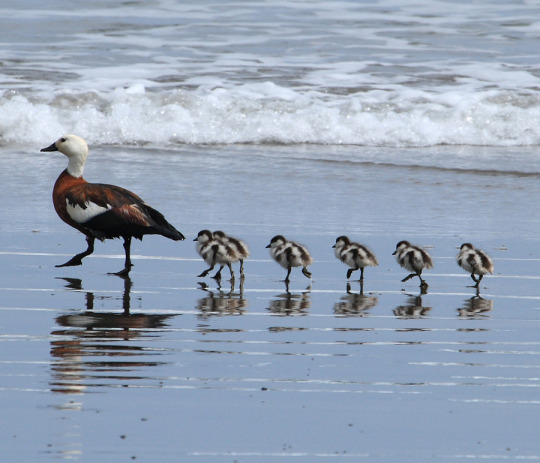
Paradise Shelduck by Dave Young, CC BY 2.0
The Paradise Shelduck is our last species in the genus, also luckily not threatened with extinction. They also don’t live in large flocks, primarily living in lifelong pair bonds and small families after the eggs hatch. They are known from New Zealand and nowhere else, so honestly in my opinion its a small miracle they aren’t threatened with extinction. They graze on grass and weeds, even crops, and they tend to be similar in coloration to other Shelducks, though the females are the ones with white patches in their plumage.
Buy the author a coffee: http://ko-fi.com/kulindadromeus
Sources:
https://en.wikipedia.org/wiki/Shelduck
https://en.wikipedia.org/wiki/Crested_shelduck
https://en.wikipedia.org/wiki/Common_shelduck
https://en.wikipedia.org/wiki/South_African_shelduck
https://en.wikipedia.org/wiki/Ruddy_shelduck
https://en.wikipedia.org/wiki/Australian_shelduck
https://en.wikipedia.org/wiki/Paradise_shelduck
#shelduck#tadorna#bird#dinosaur#duck#ruddy shelduck#south african shelduck#australian shelduck#paradise shelduck#crested shelduck#common shelduck#tadorna cristata#tadorna tadorna#tadorna cana#tadorna ferruginea#tadorna tadornoides#tadorna variegata#dinosaurs#palaeoblr#paleontology#prehistory#prehistoric life#biology#a dinosaur a day#a-dinosaur-a-day#dinosaur of the day#dinosaur-of-the-day#science#nature#factfile
82 notes
·
View notes
Note
Love your ducks. They make me happy and say "duck" in a stupid way everytime I see one
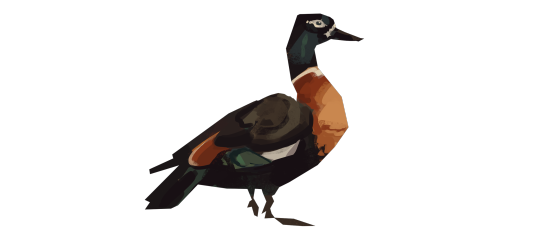
duck
146 notes
·
View notes
Text
Tadorna tadornoides / Australian Shelduck at the Sarah P. Duke Gardens at Duke University in Durham, NC
#Tadorna tadornoides#Tadorna#Australian Shelduck#Mountain duck#Chestnut-breasted Shelduck#Shelduck#Ducks#Birds#Nature photography#photographers on tumblr#Sarah P. Duke Gardens#Duke Gardens#Duke University#Durham#Durham NC#North Carolina
1 note
·
View note
Text
Most Australian Shelduck females in homosexual pairs probably go on to form heterosexual bonds as adults.
"Biological Exuberance: Animal Homosexuality and Natural Diversity" - Bruce Bagemihl
#book quote#biological exuberance#bruce bagemihl#nonfiction#australian shelduck#tadorna tadornoides#lesbian#bisexual#homosexual
0 notes